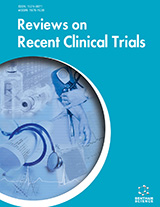Abstract
Background: Endoscopic ultrasound (EUS) has been used in the clinical arena for almost 35 years and it is now well-integrated in everyday hospital practice.
Method: We conducted a systematic review of the available English-language articles.
Objective: The purpose of this review is to summarize the relevant applications of operative EUS.
Results: More than 5000 scientific papers published in the literature have demonstrated its high accuracy for the diagnosis and staging of a variety of benign and malignant conditions. The main indications of operative EUS, both diagnostic and therapeutic, are related to its ability to combine ultrasound imaging and safe and effective needle insertion into lesions originating from the gut wall and from organs nearby. In addition, technologic advancements of echoendoscopes with a therapeutic working-channel have allowed to perform several EUS-guided interventions, i.e. celiac plexus neurolysis, drainage of fluid collections, drainage of dilated biliary and pancreatic ducts, and vascular interventions.
Keywords: Celiac plexus neurolysis, endoscopic ultrasound, EUS, EUS-guided drainage, fine needle aspiration, gallbladder drainage.
Graphical Abstract
Reviews on Recent Clinical Trials
Title:Basics in Endoscopic Ultrasound Part 2: EUS-guided Sampling and Therapeutic Applications
Volume: 13 Issue: 2
Author(s): Marta Serrani, Claudio Calvanese, Andrea Lisotti, Giancarlo Caletti, Ludovico Abenavoli and Pietro Fusaroli*
Affiliation:
- Department of Medical and Surgical Science, Gastroenterology Unit, Hospital of Imola, University of Bologna, Bologna,Italy
Keywords: Celiac plexus neurolysis, endoscopic ultrasound, EUS, EUS-guided drainage, fine needle aspiration, gallbladder drainage.
Abstract: Background: Endoscopic ultrasound (EUS) has been used in the clinical arena for almost 35 years and it is now well-integrated in everyday hospital practice.
Method: We conducted a systematic review of the available English-language articles.
Objective: The purpose of this review is to summarize the relevant applications of operative EUS.
Results: More than 5000 scientific papers published in the literature have demonstrated its high accuracy for the diagnosis and staging of a variety of benign and malignant conditions. The main indications of operative EUS, both diagnostic and therapeutic, are related to its ability to combine ultrasound imaging and safe and effective needle insertion into lesions originating from the gut wall and from organs nearby. In addition, technologic advancements of echoendoscopes with a therapeutic working-channel have allowed to perform several EUS-guided interventions, i.e. celiac plexus neurolysis, drainage of fluid collections, drainage of dilated biliary and pancreatic ducts, and vascular interventions.
Export Options
About this article
Cite this article as:
Serrani Marta, Calvanese Claudio, Lisotti Andrea , Caletti Giancarlo, Abenavoli Ludovico and Fusaroli Pietro*, Basics in Endoscopic Ultrasound Part 2: EUS-guided Sampling and Therapeutic Applications, Reviews on Recent Clinical Trials 2018; 13 (2) . https://dx.doi.org/10.2174/1574887113666171221113503
| DOI https://dx.doi.org/10.2174/1574887113666171221113503 |
Print ISSN 1574-8871 |
| Publisher Name Bentham Science Publisher |
Online ISSN 1876-1038 |
 27
27 6
6 1
1
- Author Guidelines
- Bentham Author Support Services (BASS)
- Graphical Abstracts
- Fabricating and Stating False Information
- Research Misconduct
- Post Publication Discussions and Corrections
- Publishing Ethics and Rectitude
- Increase Visibility of Your Article
- Archiving Policies
- Peer Review Workflow
- Order Your Article Before Print
- Promote Your Article
- Manuscript Transfer Facility
- Editorial Policies
- Allegations from Whistleblowers
Related Articles
-
Cytokines, Inflammation and Colon Cancer
Current Cancer Drug Targets Intracellular Signaling of the Aging Suppressor Protein Klotho
Current Molecular Medicine Peroxisome Proliferator Activated Receptor-Gamma Ligands as Potent Antineoplastic Agents
Current Medicinal Chemistry - Anti-Cancer Agents The Role of the ATP-Binding Cassette Transporter P-Glycoprotein in the Transport of β-Amyloid Across the Blood-Brain Barrier
Current Pharmaceutical Design Inhibitors of the Microsomal Prostaglandin E2 Synthase-1 as Alternative to Non Steroidal Anti-Inflammatory Drugs (NSAIDs) – A Critical Review
Current Medicinal Chemistry ω-3 Polyunsaturated Fatty Acids Effects on the Cardiometabolic Syndrome and their Role in Cardiovascular Disease Prevention: An Update from the Recent Literature
Recent Advances in Cardiovascular Drug Discovery (Discontinued) Berberine as a Promising Safe Anti-Cancer Agent- Is there a Role for Mitochondria?
Current Drug Targets Meet Our Editorial Board Member
The Natural Products Journal New Preparative Approaches for Micro and Nano Drug Delivery Carriers
Current Drug Delivery Phosphotyrosine Phosphatases in Cancer Diagnostic and Treatment
Recent Patents on DNA & Gene Sequences Relevance of Cytochrome P450 Polymorphisms in the Treatment of Helicobacter pylori Infection and Gastroesophageal Reflux Disease
Current Pharmacogenomics Gastrointestinal Immune System and Brain Dialogue Implicated in Neuroinflammatory and Neurodegenerative Diseases
Current Molecular Medicine Targeting Apoptosis Pathway with Natural Terpenoids: Implications for Treatment of Breast and Prostate Cancer
Current Drug Targets Late Life Depression: A Diagnostic and Pharmacological Review
Current Psychopharmacology Editorial [Hot Topic: Prospective Clinical Role for Anticancer Garlic Organosulfur Compounds (Guest Editor: Hassan T. Hassan)]
Anti-Cancer Agents in Medicinal Chemistry Adhesion Molecules in Lung Cancer: Implications in the Pathogenesis and Management
Current Pharmaceutical Design The Linkage Between Inflammation and Immune Tolerance: Interfering with Inflammation in Cancer
Current Cancer Drug Targets Peptide Aptamers: Development and Applications
Current Topics in Medicinal Chemistry The Role of microRNA-126 in Vascular Homeostasis
Current Vascular Pharmacology Food-Derived Peptides and Intestinal Functions
Current Pharmaceutical Design


























